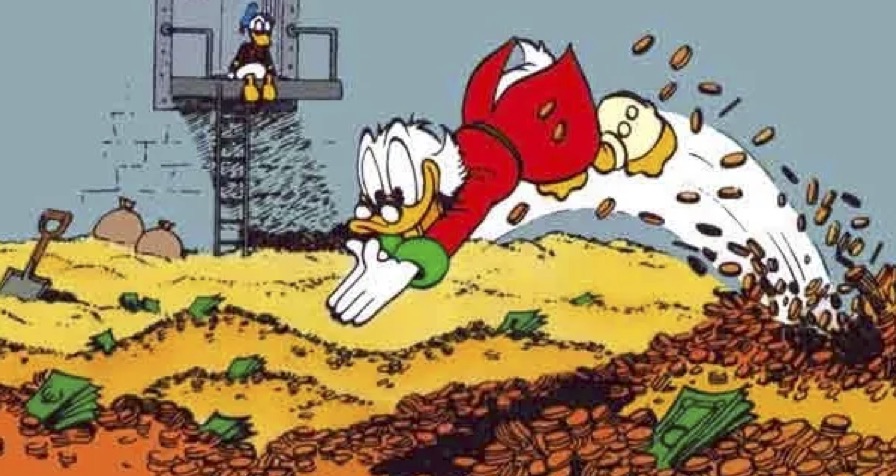The big domestic news item for the past year or so has been the high inflation rates. I always understood inflation to be the rate of increase of prices. In other words, when plotting a graph of prices, the inflation is the slope of this graph.
(This is expressed as a percentage rise per year — mathematically minded readers will then immediately realize that inflation is the slope of the graph of the logarithm of prices.)
However, this is not what is reported in the news. What is reported is the percentage price difference between now and a year ago. That is something quite different. I tried to get my head around this and this is what I found.

Let us start with a thought experiment.
Firstly, let us assume the price levels rise at a constant 2% annually. If this has been going on for quite a while, then the reported inflation figure will be 2%, because today’s prices will always be 2% higher than last year’s prices. So far so good.
Now suppose in this situation the price levels suddenly increase by 10% on the 1st Jan 2023. The reported inflation figure on the 2nd Jan 2023 will then be 12% (the 2% steady inflation plus the 10% shock price rise of 1st Jan 2023.)
On the 31st December 2023 the reported inflation is still 12%, although price levels have only been increasing by 2% annually for nearly a year. On the 2nd Jan 2024, the reported inflation level is again 2%.
Perhaps this is all fine to you, but I find it profoundly unsatisfactory that a single spike in inflation gets reported in inflation figures for a whole year exactly, only to fall away after a year.
I genuinely suspect this is our prime minister’s ruse: he claims he can get inflation down. And despite the fact he has barely any control over price levels he will probably look at more granular economic data than is reported in the news. It is very easy to see how a single inflation spike (say, due to the invasion of the Ukraine) gets inflation figures rocketing for a year and a bit, and the prime minister claims he will sort it out. Indeed, all he needs to do is sit on his backside, wait for a year, and, hey presto, the inflation suddenly drops. Marvellous.
There is some interesting maths behind all this. Suppose the price level (for example, as measured by the consumer price index) at any time is written as p(t). The instantaneous inflation I(t) then equals the time derivative of the price level:
I(t) = dp(t)/dt
But the reported inflation Ir(t) is defined as
Ir(t) = ( p(t) – p(t-Δt) ) / Δt
where Δt is a one year time interval. People with some numerical background will realize that the reported inflation Ir(t) is a backward finite difference approximation to the instantaneous inflation rate I(t). People with some numerical background will also know how to analyse such a situation.
You can do all kinds of mathematical analysis comparing Ir(t) with I(t). One fun thing is to compare how the two inflation measures perform for economic cycles of a certain period. The graph below shows one outcome of this comparison

The graph shows how for a price level cycle of a certain period (x-axis) the reported inflation figure Ir(t) underestimates the actual variation in price level (y-axis).
Looking at the graph, we see that for long cycles, 10 years or more, the reported inflation figure is nearly the same as the actual inflation figure.
But annual price cycles, such as seasonal sales, or seasonal variations in agricultural production, are completely invisible to the reported inflation figure: you can see in the graph that cycles with a periodicity of 1 year get completely filtered out of the reported inflation.
In fact all cycles of less than a year get reduced by a factor of at least 5 when comparing reported inflation with the instantaneous inflation. So this reported inflation is a terrible way to keep an accurate finger on the economic pulse.
In fact, natural phenomena that vary over several years, for example the El Niño phenomenon, will no doubt have some influence on price levels, while the reported inflation figures make the fluctuations look substantially smaller.
Perhaps there is some truth in the idea that people feel that prices keep on changing (increasing, mainly) while the news perhaps doesn’t sound that alarmist. It could simply be that, by construction, the reported inflation figure shows a much reduced picture of the actual price fluctuations.
And I still think that our prime minister is using this property of the reported inflation figure for his pledge of “halving inflation.” Let’s wait and see; we shouldn’t be too surprised if that is a pledge that will actually come true, particularly given that all that needs to be done to achieve this is sitting on one’s backside.
